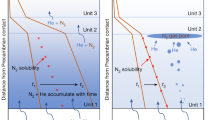Abstract
Heat flow and the origin of helium in natural gases from fault basins of the continental rift-valley in eastern China are discussed in terms of helium isotope geochemistry.3He/4He ratios in natural gases from the rift-valley range from 2.23 × 10−7 to 7.21 × 10−6, which are directly proportional to the concentration of helium and ΣNHC/ΣHC ratio in natural gases. Geological and isotope geochemical data suggest that helium in natural gases consists predominantly of crustal radio-genic and upper mantle-derived helium. In a simple mixing pattern between crustal He and mantle-derived He, mantle-derived helium in natural gases would account for 10–60%. Calculated values for heat flow (Q) range from 59.7 to 82.4mWm−2, of which about 60 percent in the rift-valley is derived from the upper mantle. Natural helium reservoirs would be found in the areas where the upper mantle uplifted greatly and heat flow is large in the continental rift-valley.
Similar content being viewed by others
References
Chen J. et al., 1982, Earth’s Rift-valley (in Chinese version): Beijing, Geological Publishing House, p. 119–126.
Chen M., 1988, Geothermics in Northern China: Beijing, Science and Technology Press, p. 58–85 (in Chinese).
Chi J., 1988. The Study of Cenozoic Basalts and Upper Mantle beneath Eastern China: China Univ. Geol. Press, p. 109–126, 177–218 (in Chinese).
Du J., 1989, Geochemistry of light noble gases: Geology-geochemistry, n.4, p. 56–59 (in Chinese).
Du J. and Liu, 1991, Geochemistry of non-hydrocarbons in natural gases in the Sanshui Basin, Guangdong Province, China: Chinese J. Geochem., v. 10, n.4, p. 318–325.
Ma X. and Xu J., 1985, Taphrogenesis through the geological history of China, Research on Recent Crustal Movement (1): Seismological Press, p. 5–16 (in Chinese).
Mamyrin, B.A. and L.N. Tolstikhin, 1984, Helium Isotopes in Nature: Elsevier Sci. Publ. B.V.
Morgan, P., W.N. Sawka, and K.P. Furlong, 1987, Introduction: Background and implications of the linear heat flow-heat production relationship: Geophys. Res. Lett., v. 14, p. 248–251.
Nier, A.O., D. J. Schlutter, and D. E. Brownlee, 1990, Helium and neon isotopes in deep Pacific Ocean sediments: Geochim. Cosmochim. Acta, v. 54, p. 173–182.
Polyak, B.G., I.N. Tolstikhin and V.P. Yakutceni, 1979, Izotopniy sostav geliya i leplovoy polok: geocheskit i geofizicheskiy aspekti teklogeneza Geotektonika, v. 1979, p. 3–23 (in Russian).
Polyak, B.G., E.M. Prasolov, V. Cermak, and A.B. Verkhovskiy, 1985, Isotopic composition of noble gases in geothermal fluids of the Krusne Hory Mts., Czecnostovakia, and the nature of the local geothermal anomaly: Geochim. Cosmochim. Acta, v. 49, p. 695–699.
Tedesco, D., P. Allard, Y. Sano, H. Wakita, and R. Pece, 1990,3He in subaerial and submarine fumaroles of Campi Flegrei caldera, Italy: Geochim. Cosmochim. Acta, v. 54, p. 1105–1116.
Torgenson, T. and W.B. Clark, 1982, Helium accumulation in groundwater, III. Limits on helium transfer across the mantle-crust boundary beneath Australia and the magnitude of mantle degassing: Earth Planet. Sci. Lett., v. 84, p. 345–355.
Wang J. and Huang S., 1988, Compilation of heat flow data for the continental area of China: Scientia Geologica Sinica, n. 2, p. 196–204 (in Chinese).
Wang J. and Huang S., 1987, Linear relationship between heat flow and heat production in the Paxi Paleorift zone, southeastern China:. Geophys. Res. Lett., v. 14, p. 272–274.
Wu Q., Xie Y., Zu J. and Wang D., 1985, Terrestrial heat flow and seismicity in North China: Res. Rece. Crust. Movem., Beijing, Seismolo. Press, p. 135–141.
Welhan, J.A. et al., 1988, Helium isotopes in geothermal and volcanic gases of western United States: J. Volcanol. Geotherm. Res., v. 34, p. 201–209.
Xu Y., Shen P., Sun M. and Xu S., 1990, Non-hydrocarbon and noble gas geochemistry in natural gases of eastern China: Sci. Sinica (Series B), v. 33, p. 1495–1503.
Xu Y., Shen P., Tao M. and Sun M., 1991, Industrial accumulation of mantle source helium and the Tancheng-Lujiang fracture zone: Kexue Tongbao (Bulletin of Science), v. 36, p. 494–498.
Author information
Authors and Affiliations
Additional information
The project is financially supported by the National Natural Science Foundation of China.
Rights and permissions
About this article
Cite this article
Jianguo, D. 3He/4He ratios and heat flow in the continental rift-valley, eastern China. Chin. J. of Geochem. 11, 237–243 (1992). https://doi.org/10.1007/BF02842268
Issue Date:
DOI: https://doi.org/10.1007/BF02842268




